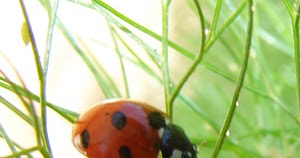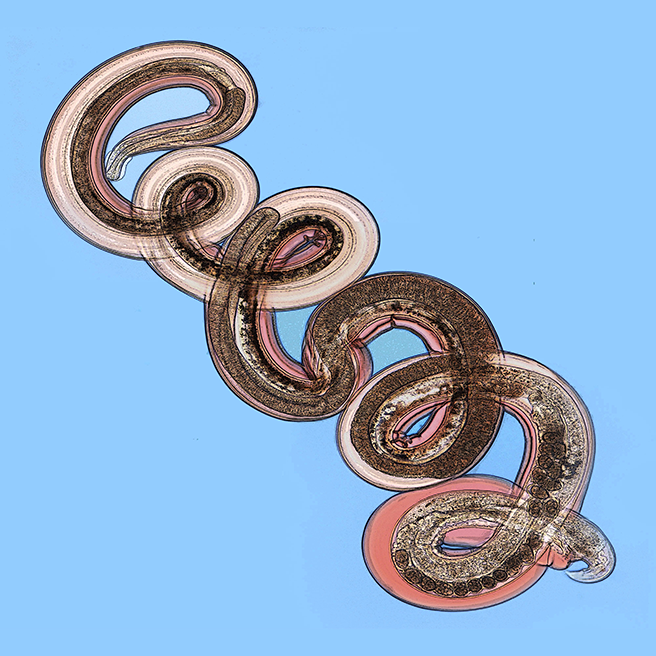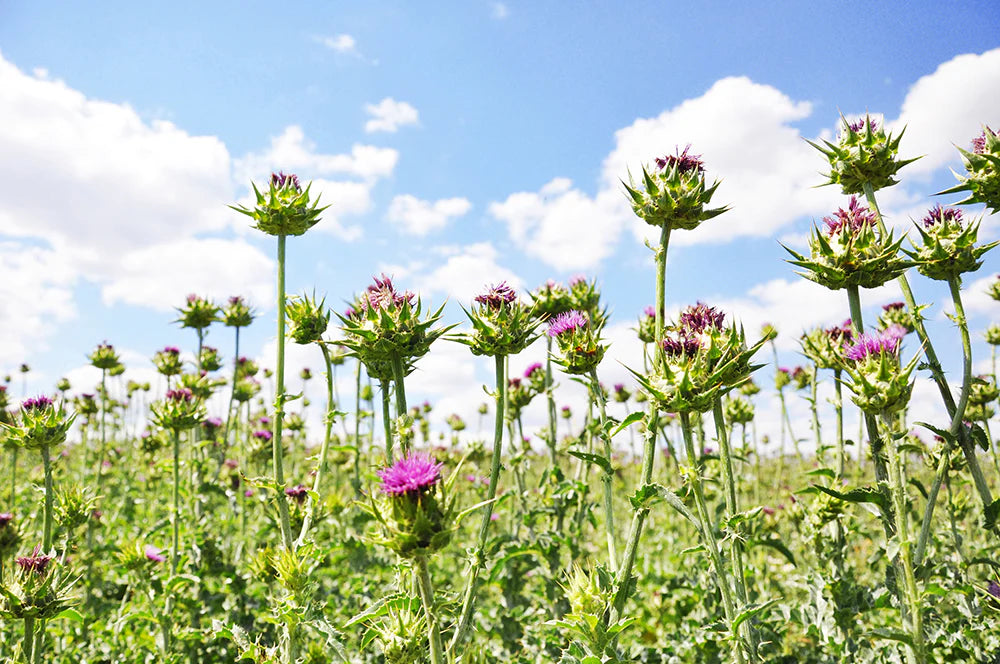Ladybird = Good Bug
Scale Insect = Bad Bug
The idea of ‘Companion Planting’ is familiar to most people these days, we know that planting Basil in with our tomatoes can improve their flavour and planting French Marigolds (Tagete patula) will deter whitefly from our toms. Using herbal medicine to treat people and even animals is something that is widely accepted and practised in our historical past and currently, but using plant based medicine to cure plants seems to be something that isn’t so well known. My latest Garden News article focuses on using herbs as first aid for the garden and in it I mentioned a few DIY herbal garden remedies you can make for yourself, so I thought it would be a good idea to add the recipes to my blog for those that want to have a go at making the recipes and trying them out for themselves.
It would be easy once you’ve spotted something growing or munching on your herbs, to blast it away with the chemical version of a shotgun, but if you intend to eat them, an environmentally friendly approach to pest and disease control is required. Many herbs contain protective chemicals within their roots or foliage which can naturally tackle pests and diseases, for example T. patula mentioned above, exudes a natural chemical thiopene into the ground that kills off any bad soil nematodes in the soil surrounding them. Using the naturally occurring chemicals in many of our herbs aerial parts and roots can help combat a string of common garden pests and diseases. Don’t forget to encourage good bugs such as Ladybirds, Lacewings and Hoverflies into the garden by growing nectar rich flowering herbs such as those covered in my herbs for bees article. I’ve put together a short video below that shows 12 herbs that can be used as herbal first aid for the garden with small factoids and tips, click on the YouTube video below to view it.
‘Anti-Vampire Garlic Spray’
Garlic contains a good dose of natural sulphur so as well as being a perfect deterrent for controlling mealy bugs, aphids and other little ‘vampire’ sap sucking insects, it will also act as an antibacterial agent and can help prevent fungal diseases.
100g Garlic, Minced or Finely Chopped
30 ml Liquid Paraffin or Vegetable Oil
1 Tbsp Horticultural Liquid Soap
10 ml Garlic Essential Oil
470 ml Water
Don’t worry about peeling the garlic first, use the whole cloves, skin and all! To get the highest yield of natural oil from the cloves, bruise them first, use the flat of a large kitchen knife, put your knife flat on to the garlic clove and hit the knife with your hand, this will make the garlic release more of its natural oils and the sulphurous chemicals we want in our spray. To make up this recipe, soak the minced garlic in the liquid paraffin/vegetable oil for 24 hours at room temperature.
After 24 hours, strain the garlic from the oil and using a spray bottle that holds 1 litre or more, pour the garlic infused oil in to the spray bottle, next add the horticultural soap, you can use washing up liquid if you don’t have any, next add your garlic oil and then slowly pour in the water. Put the lid on the bottle and give the spray a vigorous shake to mix the oils and water together. Spray onto plants you wish to protect, never spray in full sun as the plant will scorch. Keep the spray in fridge or a similar cool place to prevent it going off, this spray can last up to 2 months if stored correctly.
Herbal Spray’s
Yarrow (Achillea millefolium) – With its built in insecticidal properties yarrow is an excellent herb for turning into a spray to help deter pests such as aphids, it’s also an excellent natural fertiliser and believe it or not compost activator! To make a yarrow spray put 150g fresh chopped Yarrow leaves and flowers into a pan with 500ml water and bring to the boil, once boiled, turn off the heat and leave the yarrow ‘tea’ for 24 hours, after this time strain and plant material out and add the ‘tea’ to a spray bottle to which you’ve put a teaspoon of horticultural soap in to, put the lid on securely and shake the bottle to mix. Use as a spray to deter aphids and other soft bodied pests as needed.Chamomile (Matricaria chamomilla) – Chamomile doesn’t just make a relaxing tea; you can use its fungicidal properties as a foliar spray to prevent damping-off disease and planting it in amongst other plants will help to boost their health. To make this spray make up a strong brew of chamomile tea, from fresh chamomile if you can get it, if not dried will do, leave to steep for a few hours (the longer the better), once cold add to a spray bottle and spray at the first signs of damping off disease or other fungal diseases. This spray will keep in the fridge for a few days but is best made up fresh when you need it.Pot Marigold (Calendula officinalis) – This is a super spray to help deter asparagus beetles, tomato hornworms and other leaf cutting/chewing pests, that can make a mess of your your roses and other plants. Make up in the same way as the Yarrow spray substituting Marigold leaves and flowers for the Yarrow. Spray at the first sign of attack.
Neem Tree (Azadirachta indica)
Blackfly on Crampbark
Magic Neem Mist
Last weekend I visited a friends garden and she told me all about the new Neem (Azadirachta indica) spray that she’d been making and using on her garden, I was amazed at the results she’d obtained with this, I dubbed it a magical cure all. My friend happily shared the recipe with me and offered the following tips with my readers. “I have found my Neem spray especially good for reducing white fly on Stevia plants in the greenhouse (it does not completely eliminate them – but gets them to tolerable levels) its also useful for deterring slugs on dahlias and on hostas. It is also good for reducing blackfly on sweet cicely, ox-eyed daisies and valerian flowerheads. It’s prevented the decimation of my Cramp bark shrub with the dreaded Viburnum moth caterpillars at the beginning of the season and also saved the Mullien from Mullein moth caterpillars – this year I’ve had the most and healthiest looking complete leaves I’ve ever seen on the Mulleins! Also using the Neem Spray on my roses I’ve found that they have less black spot fungus.”
30 ml Sightly Warmed Neem Oil
1.25 Litres Warm Water
Dash of Washing Up Liquid.
Simply mix all 3 ingredients in a garden spray bottle. Keep the mixture in the airing cupboard in the spraying or some place warm prior to use to avoid the oil solidifying. If allowed to get cold neem oil becomes solid. Shake before spraying. Spray under leaves if at all possible, this will mean that the neem solution will not get washed off in the rain and any pests that hide under the plants leaves will get a nasty taste in their mouths!
Comfrey Liquid Feed
Comfrey makes an excellent albeit stinky liquid feed for the garden , pick a handful of leaves and place them in a container with enough water to cover them. Cover the container and leave to ‘cook’ for 4 weeks in cold weather or 2 weeks in hot weather. Then, holding your nose, strain and squeeze the leaves to extract as much liquid as possible Use as a foliar feed at a rate of 3floz (90ml) Comfrey liquid to one gallon (3.5 litres) of water. Comfrey can be invasive, try growing the Russian Comfrey variety ‘Bocking No. 14’, this variety is one of the least invasive and has a good resistance to rust which can be a problem with Comfrey.
Nettles are very mineral rich with high levels of silica and calcium, a nettle infusion sprayed onto plants will act as a tonic, and help improve their disease resistance. Leave the infusion to ferment like Comfrey liquid and it an be used in the same way as a mineral rich foliar feed. You can do exactly the same thing with Nettle (Urticara dioca), they are very mineral rich with high levels of silica and calcium, a nettle infusion sprayed onto plants will act as a tonic, and help improve their disease resistance. Leave the infusion to ferment like comfrey liquid recipe above and it an be used in the same way as a mineral rich foliar feed.
Gardeners Hand Cream
10g Marshmallow Flowers or Leaves
10g Chamomile Flowers
200ml Mineral Water
10g Beeswax, Grated
10g Shea Butter
50ml Calendula Infused Oil
10 Drops Lavender Essential Oil
5 Drops Tea Tree Essential Oil
5 Drops Orange Essential Oil
5 Drops Benzoin Essential Oil or a Vit E Capsule to act as a preservative.
1) Put the marshmallow and chamomile into a pan with the mineral water, bring to the the boil then leave to simmer for 10 minutes. Take it off the heat and allow it to become lukewarm, then strain the herbs from the liquid, measure 40ml’s of the herb infused water and pour it back into the pan.
2) Using a double boiler heat the Calendula oil, Shea butter and Beeswax gently together until melted, once melted, reheat the herbal infusion made in stage 1 until it’s almost boiling, and add it to the oil/butter/wax mixture a little at a time whisking it together with a hand-whisk or an electric mix until all the ‘water’ has been whipped into the oil/butter/wax mixture.
3) Whisk in the essential oils and the contents of the Vit E capsule if using, pour the cream into clean sterilised jars and seal. Use after washing hands or as a barrier cream prior to tackling tough garden jobs.


